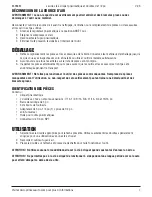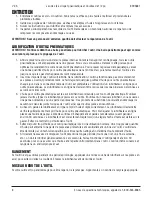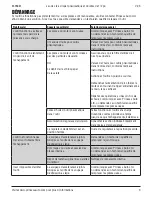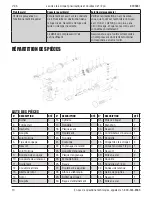
1/2 in. Air Ratchet and Socket Set
5
Visit www.princessauto.com for more information
8395881
V 2.5
SPECIFIC SAFETY PRECAUTIONS
1. Air tools produce more noise than their electric counterparts. Extended exposure to this noise may cause
hearing loss.
a. Wear ear protection gear to eliminate or reduce the noise.
2. Do not operate this tool if the air hose is damaged.
a. Inspect the air line for cracks, fraying or other faults before each use.
b. Discontinue use if a hissing can be heard from the air line or connectors while operating the tool.
c. Take the following steps if either of the above situations occur:
i. Tag or mark the tool as ‘defective’ or ‘out of service’ until repaired.
ii. Contact a qualified person to repair or replace the defective component/hose.
3. Prevent damage to air hose by observing the following:
a. Never use the hose to carry the tool.
b. Keep the air hose of the tool and the tool’s work path while in operation. The hose should always stay
behind the tool.
c. Keep the hose away from heat, oil, sharp edges or moving parts.
d. Do not allow people, mobile equipment or vehicles to pass over unprotected air hose.
i. Position air hose away from traffic areas.
ii. Place hose in reinforced conduit.
iii. Place planks on either side of the hose to create a protective trench.
e. Do not wrap hose around the tool as sharp edges may pierce the hose or cause cracks if wound too
tight. Gently coil the hose and either hang on a hook or fasten with a device to keep hose together
when storing.
4. An air hose under pressure that is damaged or disconnected from an air tool may whip around and cause
damage to the work area or personal injury. Secure the compressor’s air hose to a fixed or permanent
structure with clamps or cable ties.
5. Do not over-tighten nuts. They could shatter and cause damage to the tool or workpiece or cause serious
injury. Use a torque wrench to torque the nut after using the air ratchet.
6. Do not apply any additional force on the ratchet order to remove a nut.
7. Do not allow ratchet to run without load for an extended period of time as this will shorten its life.
8. This air ratchet should only be used with impact sockets and extensions. Use of other accessories can cause
them to break, which could damage the unit or cause injury.
USE AND CARE OF TOOL
1. Use the correct tool for the job. Do not force a tool or attachment to do the work of a larger industrial tool.
Maximize tool performance and safety by using the tool for its intended task.
2. This tool was designed for a specific function. Do not modify or alter this tool or use it for an
unintended purpose.
3. Securely hold this tool using both hands. Using only one hand can result in loss of control.
4. Maintain tools with care (see Maintenance).
5. Avoid unintentional starts. Be sure that the trigger is in the neutral or OFF position when not in use and
before connecting it to any air source.
6. Do not carry the tool with fingers near or on the trigger.




















